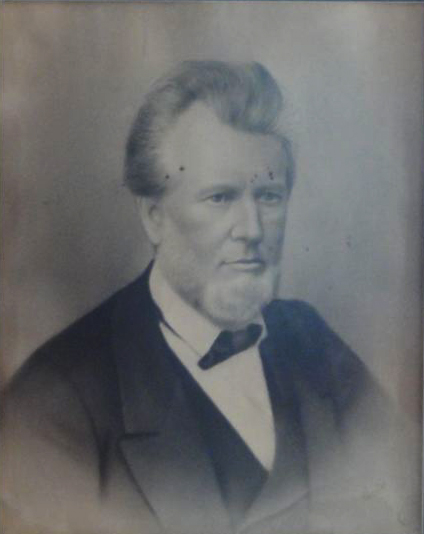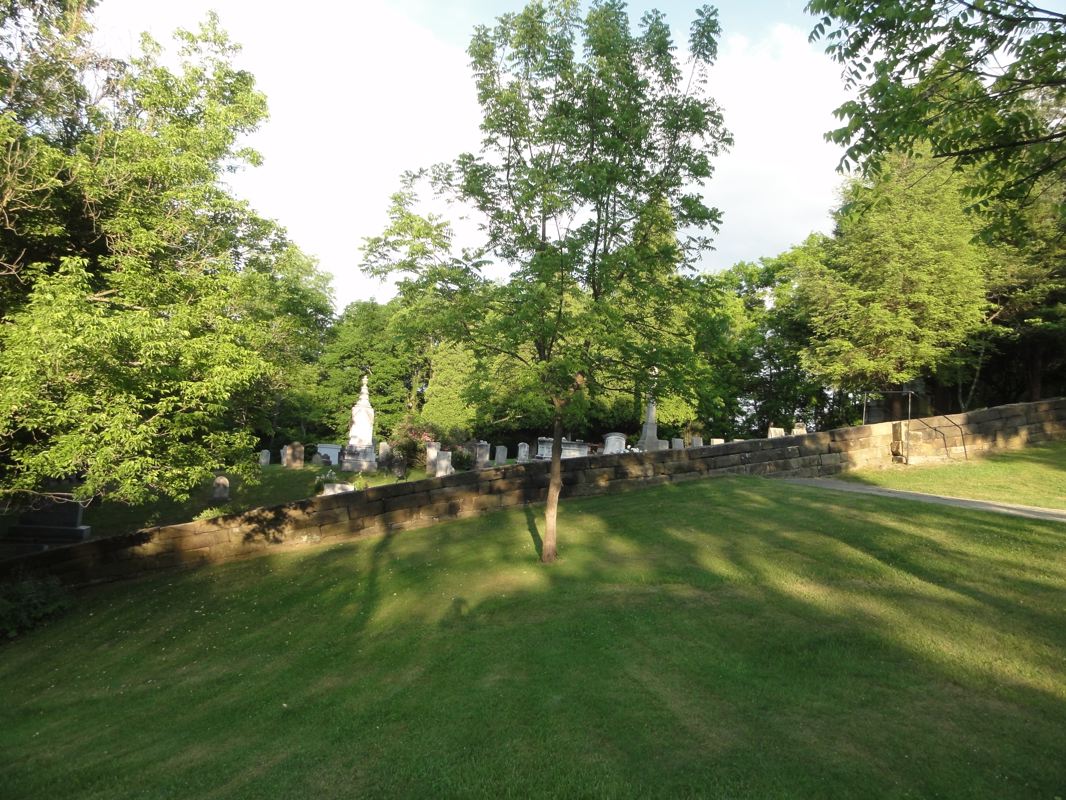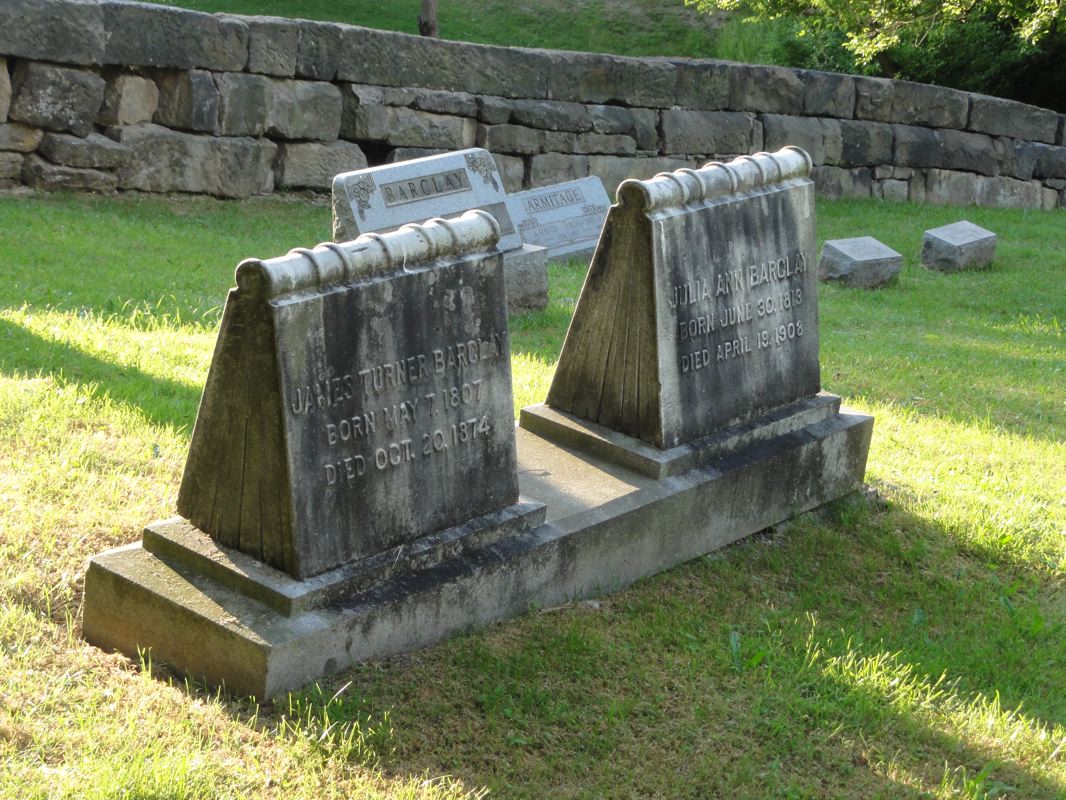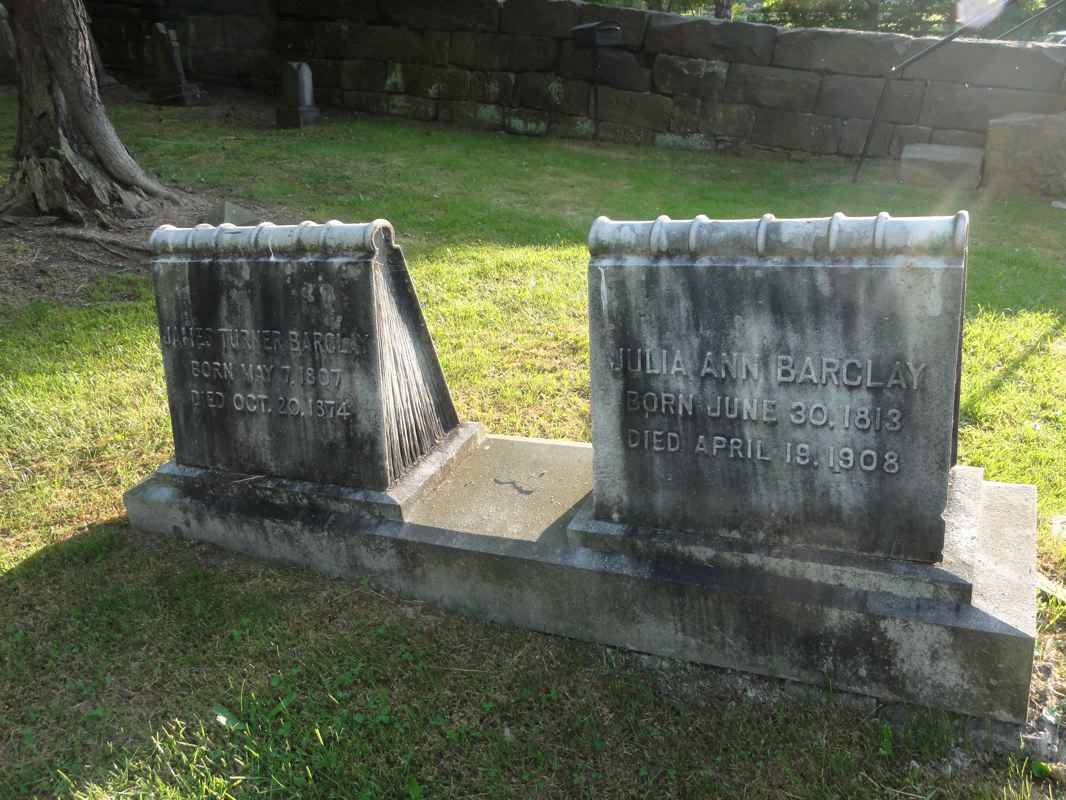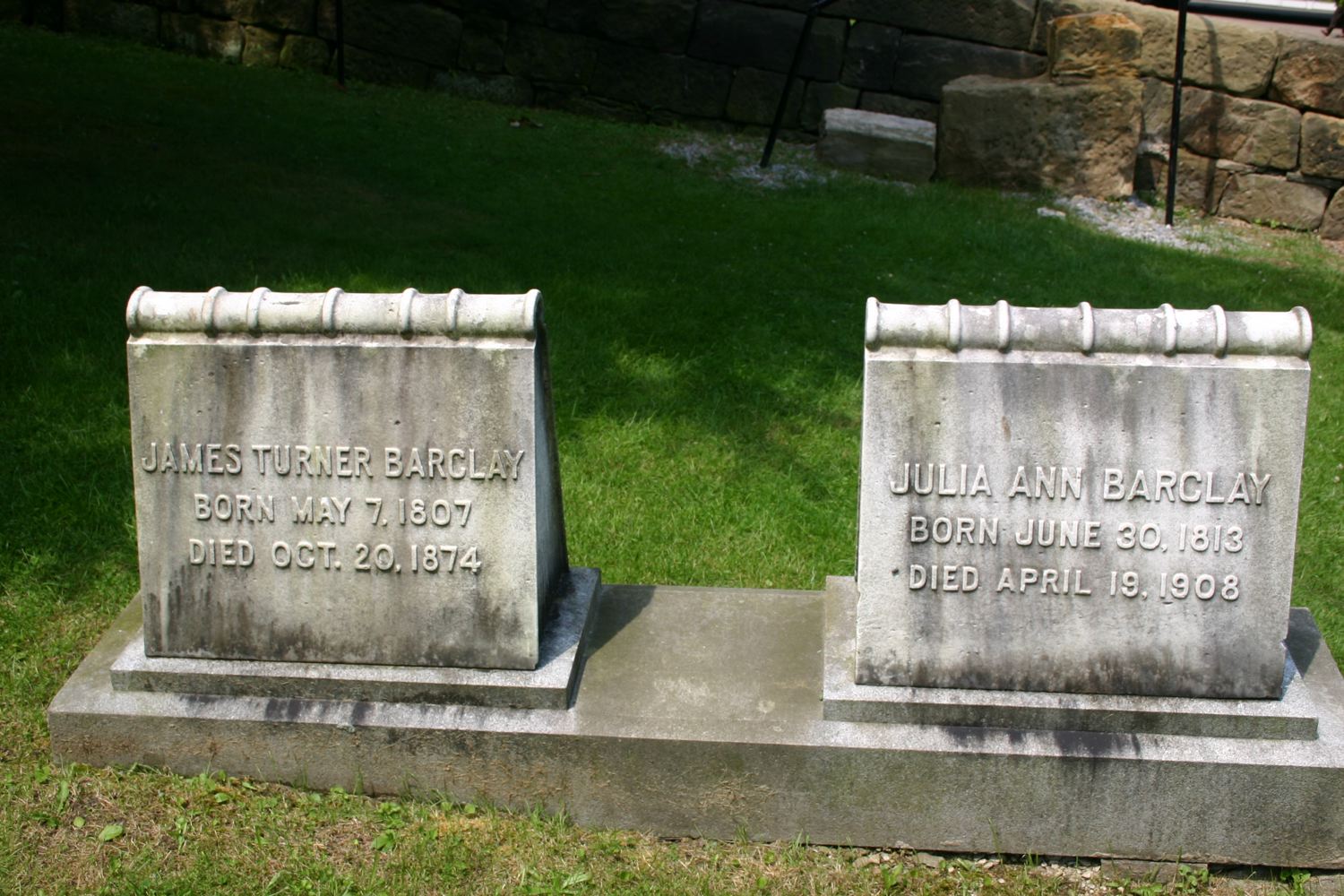James Turner Barclay
1807-1874

![]()
Sketch on the Life of J.T. Barclay
James Turner Barclay was born in Hanover county, Virginia, on the 22nd day of May, 1807. His father, Robert Barclay, was the son of Thomas Barclay, of Quaker descent from Barclay of Urie, the Quaker apologist, and an intimate and cherished friend of Washington and Jefferson. His mother, Sarah Coleman Turner, was left a widow when James was a little boy. She afterwards married Captain Harris, a wealthy tobacco planter, of Albemarle county, Virginia. He was devoted to James, and educated him at the University of Virginia. In his twenty-second year he graduated in medicine at the University of Pennsylvania. Dr. Barclay was married in 1830 to Miss Julia A. Sowers, of Staunton, Virginia, who is in her ninety-first year, and living with her son and his wife, Decima Campbell Barclay, in the old Campbell mansion at Bethany, West Virginia. Shortly after their marriage he purchased Monticello, the home of Thomas Jefferson, from the Randolph heirs, and lived there for some three or four years. Finally he was persuaded by his mother and his wife's parents to dispose of the place, which he sold to Captain Uriah P. Levy, of the United States Navy. In early life he joined the Presbyterian church, and was most earnest in his desire to go as a missionary to China. He offered himself to the Presbyterian Board of Missions, but afterwards yielded to the entreaties of his aged mother not to leave her to go to a foreign land. A few years later he became convinced of the importance of believer's baptism, and embraced the views of the disciples of Christ, as taught in the New Testament, and illustrated in the life of his Divine Lord and Savior, and taught by His apostles, which constituted the joy of his hope, the strength of his faith, and the life of his love throughout his eventful and consecrated life. He was baptized by R. L. Coleman in the James River, at Scottsville. Afterwards he moved to Washington City and organized our first church there in his own house. A short time after the death of his mother, he offered his services to the American Christian Missionary Society, and in 1850 went to Jerusalem as our first missionary to the Holy Land, with the one desire of his heart to proclaim from Mt. Zion the Kingdom of Christ as on the day of Pentecost. There, on the ground, he prepared the material for his book, "The City of the Great King." This work is a standard authority on Jerusalem in England as well as America. On his return to the United States, in 1854, he published this book. The next year he was appointed by the President in special charge of the Philadelphia mint, to make experiments and tests to prevent counterfeiting and the deterioration of the metallic currency. This important work he successfully accomplished. The result of his experiments and his report were fully indorsed by Professors Rodgers, and Vatheck, two eminent scientists of Philadelphia, who had been appointed by the President to co-operate with him. When the matter of remunerating him for his discovery was brought before Congress, a bill passed the House giving him $100,000. It failed to pass the Senate by one vote, cast by Senator Mason. In 1858 he returned to the missionary work in Jerusalem, with renewed zeal and energy. On the breaking out of the Civil War, in 1861, he resigned his position, not wishing to be a tax on his brotherhood in time of war. For a time he lived with his children in Beirut, Syria, and on the Island of Cyprus. In 1865 he returned to America, and the next year was called to the chair of Natural Sciences in Bethany College. This position he resigned in 1868 and removed to Alabama, where he spent the remainder of his life, preaching through the mountains and villages of Northern Alabama. He organized the little church in Wheeler, Alabama, where his memory is cherished and honored by all who knew him. There he was buried on the plantation of his oldest son, Dr. R. G. Barclay, who survived him only two years. Dr. Barclay was a man of wonderful constitution and fine physique. At the time of his death he was sixty-seven years and five months old, yet his sight was perfect. He read the Bible in the finest print without glasses. He could write the Lord's prayer, in a clear, distinct hand in characters so small that they could all be inscribed on a five cent piece. His teeth were all strong and perfect at the time of his death. His memory and mental powers were not in the least impaired. One who knew him well states that he was a most diffident and retiring man. Bro. Hobson once remarked of him that "Dr. Barclay was criminally modest." Because of his connection with and devotion to our missionary work his name will be held in everlasting remembrance by our people. The pulses of his great and benevolent heart and self-denying life in the Master's service in Christian, as well as heathen, lands are still the pulse of this world's life and are beating in these latter days with greater force than ever.
A marked characteristic in the mental and moral make up of Dr. Barclay was his enthusiastic devotion to prophecy, of which he took a literal view and upon which he read, talked and wrote incessantly during the last years of his life, and his chronological and prophetical maps and charts are something wonderful in the way of exact and minute work. He was a line draughtsman and spent months absorbed in these maps and charts. Another feature was his intense love and study of the Bible, which he read continually, his morning, mid-day and evening devotion literally wearing out Bible after Bible by his constant use of them. I remember hearing him say that he read the Bible from Genesis to Revelation every six weeks. He was so familiar with the Scriptures that he could refer at will to almost any passage that was brought up for comment or discussion. On his library shelves were all of the latest prophetic works, the "Battle of Armageddon," by Baldwin, the writings of Dr. Cummings, of London, and Dr Seiss' "Last Times," and "Pisgah Views," were read with deep interest by him. But the chief love of his heart was for missions and missionary work, in which service he knew no weariness. "Servant of God, well done, rest from thy fond employ, the battle fought, the victory won, enter thy Master's joy."
-J.T. Barclay, Churches of Christ, ed. John T. Brown, 1904, pages 440,441
![]()
Advertisement For Barclay's Book:
The City Of The Great King
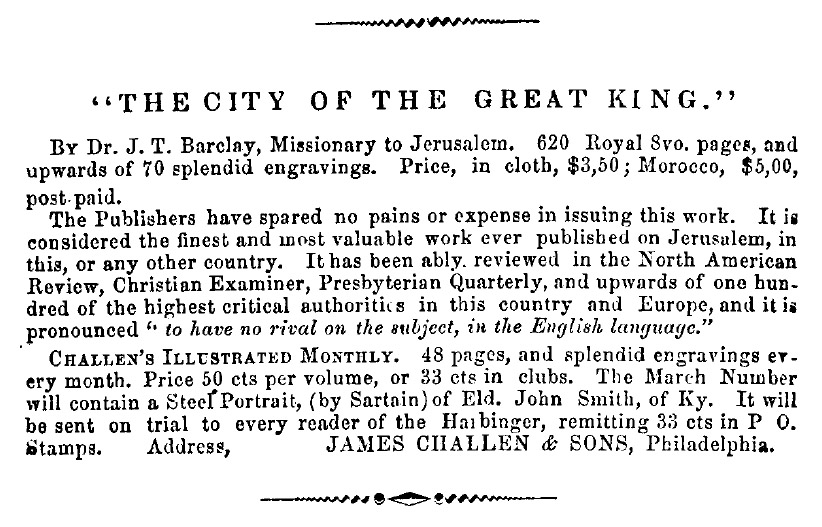
From Millennial Harbinger, 1858, page 240
![]()
The Jerusalem Mission
The cause of restoring New Testament Christianity went to wreck on the word "cooperation." The earliest differences the church arose over cooperation, and not over instrumental music. The seeds of this trouble are found back as far as the Mahoning Association. The differences burst more violently into the open after the founding of the American Christian Missionary Society in 1849. From then on there was open warfare among the pioneers.
At first some of the most loyal of the preachers were uncertain as to the course to pursue. Tolbert Fanning at this time was following along with the general drift. Benjamin Franklin was among the most ardent supporters of the society efforts then, too. During the last half of the nineteenth century there was no consistent effort to "draw lines" on this liberalizing effort in the church. Moses E. Lard had advocated the withdrawal from any church that used the instrument, but there was no large effort as yet toward this end. By 1906, however, the "Christian Church," or "Disciples of Christ," and the "churches of Christ" were listed separately in the national census reports. Our pioneers saw by then that there was to be little success in checking the drift into digression. To prevent some of the churches from being swept into the current the lines were rigidly drawn.
The establishment of the American Christian Missionary Society was the major effort of the church toward cooperation. Everything else was considered subordinate. The first real test of the missionary society came in the sending of Dr. James Turner Barclay to Jerusalem. Here, for the first time, the cooperative efforts were being put to a practical test. Owing, therefore, to the significance of this event, attention is here called to a sketch of the life and work of Dr. Barclay.
EARLY LIFE
The name "Barclay" can be traced to Berkley, in Gloucestershire, in the time of William the Conqueror. Thomas Barclay, grandfather of James T. Barclay, was one of the early settlers in this country. He was the first consul from the United States to France, being appointed by the Continental Congress In 1781. Robert Barclay, father of James T., was a moderately wealthy businessman. He was drowned in 1809 in crossing a swollen river in King and Queen County, Va. James T. Barclay was born May 22, 1807, at Hanover Courthouse, Va. He received his early education at Staunton Academy, Va. At the age of seventeen he entered the University of Virginia. He graduated from the school of chemistry in 1826, and upon graduation was offered the chair of chemistry, but declined it. The next two years he attended the University of Pennsylvania medical school and secured his permit to practice medicine. Two years later he married Julin Ann Sowers, of Staunton, Va.
Six years after the death of Thomas Jefferson, Barclay purchased the famous Monticello home from Jefferson's grandson, Jefferson Randolph, for $7,500. Barclay at that time lived in Charlottesville in a home valued at $4,500. He traded this and gave $3,000 extra for the Monticello home. Monticello, it will be recalled, was designed by Thomas Jefferson himself when he was but twenty-one years old. He completed the building of it in 1802 at a cost of $7,200. Bricks for the home were made on the ground, and the nails were made by Jefferson's own Negro boys. The home was run down when Barclay got it, and he repaired it to make it look very much like a mansion. He was once offered $20,000 for it, but turned it down. When he did sell it, he lost over $2,000 on the sale.
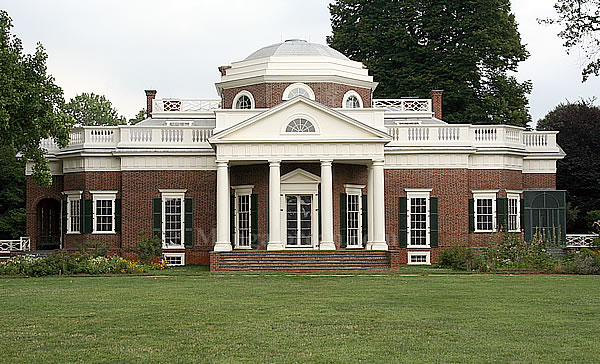
Monticello, Virginia
The Barclays were Presbyterians and deeply religious. Barclay's early ambition was to be a missionary to China under the Presbyterian Missionary Society, but his mother would not hear to it. About 1839, after the death of his mother, they heard the preaching of a Brother R. L. Coleman, and were baptized by him in the James River, near Scottsville, Va. Barclay himself went to work and established a New Testament church in Scottsville. The old building still stands, but is owned by "St. James Lutheran Church." He went to Washington, D. C., and established the first church there. This church met first in his home, then in the fire station, and then in the city hall.
OFF FOR JERUSALEM
In the late 1840's, when Barclay heard of the possibility of the church establishing a missionary society, he decided that he wanted to be the first missionary. Particularly was he interested in going to Jerusalem, and he had a definite reason for it. He believed that Rom. 11 taught the Jews would all be converted to Christ. He figured somebody had to start to convert them, so he might as well be the one. He imagined himself as being the leader in the movement, which he considered imminent, to convert the Jews. He had no doubts that when they heard the gospel they would be converted almost en masse. This was Barclay's reason for choosing Jerusalem as the site.
Late in 1848 an anonymous article appeared in the Christian Age urging a mission to be established at Jerusalem. D. S. Burnet, commenting later on the article, said there was no doubt that Barclay had written it. On October 30, 1849, Barclay wrote to the society board. Soon a letter came from the church at Scottsville, and then one from Walter Scott. The next year Barclay was recommended by the society to the mission at $1,200 a year. Now, the effort began to raise money.
John Boggs was the agent In charge of getting the funds. He went to the churches in Ohio, Kentucky, Virginia, and Pennsylvania. The results were very poor. The reason is often given that Barclay was a slaveholder, and that the Northern churches would not consent to back him for this reason. At any rate, Barclay, to keep himself clear of criticism, sold his slaves.
On September 14, 1850, the Barclay family left for Jerusalem on board the Devonshire. The sea was rough, and Barclay was sick most of the way. He landed in London in twenty-one days. After some difficulty, he finally left London on board the Hebe, a small vessel. that took him to Malta. From Malta he took a steamer to Beirut, and from there rode horseback through Tyre, Sidon, Ptolemais, and Joppa to Jerusalem, where he arrived on February 10, 1851.
The Barclays settled in a room near the Damascus Gate, in the Christian quarter of the city. The first task was to learn the Arabic language, which was finally done. The chief men of the city were then contacted. For three and a half years Barclay labored in Jerusalem. Thirty-one persons in all were baptized. Barclay preached. practiced medicine, tried to run a small school, and did some exploring during this time. He wrote that Jerusalem was the most wicked place on earth, especially in the "Christian" section. Opposition from Protestants and Catholics was strong. He was told that be had better join the Anglican Church if he wanted to escape persecution. Amid these trials he continued. Finally, in the summer of 1854, funds got low and he returned to America.
TO THE UNITED STATES AND BACK
Barclay remained at home for nearly four years. In 1855 President Franklin Pierce appointed him to a special position to carry on experiments in the mint at Philadelphia for the prevention and deterioration of the metallic currency. He was successful, and the House of Representatives voted to give him $100,000 for his work. The bill, however, was defeated in the Senate by one vote. During this time, one accomplishment of Barclay's stands out. It was then that he wrote his book, "The City of the Great King," which is the story of Jerusalem as it was, as it is, and as it will be. While in Jerusalem, Barclay had done some research work. Once he crawled through a sewer under the Mosque of Omar, built on the site of Solomon's temple, from the "Holy of Holies" to the "Valley of Hinnom," and measured it. It was through this sewer that the blood of the sacrifices flowed. Once he discovered a great cave where he believed stones were prepared for the temple. This information was put in his book, and he gained a great reputation among the archeologists.
But while at home Barclay paid a visit to Alexander Campbell, and told him of his desire to return to Jerusalem. It was 1858 before Barclay was able to sail for Jerusalem again. Upon his arrival, he found that all his former converts except two had left. A malaria epidemic forced his family to move out of Jerusalem to Joppa. Here he baptized about five people. Soon his son and daughter married. Then an insurrection broke out on Mount Lebanon between the Druses and Maronites, which increased the difficulty of his work. There was slaughtering and death everywhere.
Meanwhile at home the Civil War had broken out. The missionary society was in the act of recalling Barclay because of the lack of funds when they received a letter from him with his resignation. In 1863 the society decided to pay Barclay's expenses home. He arrived home in 1865, and the next year received a call to the chair of natural science at Bethany College. He stayed here until 1868, when he resigned and moved to northern Alabama. He spent the rest of his life preaching and establishing churches here. With the aid of his son, Robert, he established the church at Wheeler's Station, Ala. In the last years of his life he spent most of his time studying prophecy. He died on October 24, 1874, at Hillsboro, Lawrence County, Ala.
Barclay's work ended in failure. It was partly his fault. He was jumping from one job to another, never staying with one task to the finish. Too, he still had a lot of Presbyterianism in him. On several occasions individuals and large groups of persons came to him, asking to be baptized. He invariably refused until he sent them to his "school," so he could be sure they knew enough. But a part of the failure was due to the society, which failed to raise money to keep him in the field. It, of course, took no small amount to "oil the machinery" for the society to keep going. It was more important for the machinery to keep functioning than for the missionary to stay in his field. Thus ended the first practical attempt at cooperation to be put forth by the churches.
-Earl West, Gospel Advocate, 1946, October 24th issue, page 1006,1008
![]()
Directions To The Grave of James Turner Barclay
J.T. Barclay was initially buried in North Alabama on the farm of his son, R.G. Barclay. Some years later the family exhumed his body and had it moved to God's Acre Cemetery in the remote hills of the panhandle of West Virginia. Access of approach to Bethany can be made four ways, one of which is not great if you are prone to car sickness. The approach from Wheeling, W.V. is very curvy, on Hwy. 88. Thus, it is better from Wheeling to go up Hwy. 2, following the Ohio River to Wellsburg. Turn right on Hwy. 27 and go around five miles and turn right on Hwy. 88. Access this way is straightest from Wheeling. Once arriving in Bethany, travel all the way through, passing the church building on the right, crossing Buffalo River/Creek, passing the soccer fields on the left, and continuing until you get to the Campbell Mansion. When you see the historical marker on the right, you should turn right, but keep to the left as you go up the hill toward God's Acre Cemetery. The cemetery is enclosed with large boulders. Enter the cemetery at the steps. One of the first monuments you will come to at the entrance is that of J.T. & Julia Ann Barclay.
From Washington, P.A. - Take Exit 17/Jefferson Avenue on I-70, and head north, (away from Washington) on Hwy. 18/844. When 18 and 844 split, be sure to go left on 844. Go a few miles and turn left on Hwy 331/Brush Run Road. (There has for years been a red barn at the corner, making for a good landmark to know where to turn off Hwy. 844. onto Hwy. 331/Brush Run Road. Take 331 until it dead's end to Hwy. 231 where you will turn left. Hwy. 231 will dead back into Hwy. 331. Turn right and head into Bethany. The first glimpse of Bethany will be the old Campbell mansion on the right. Be sure to go through this house if possible. It is good to call ahead to make sure someone is able to show you through. You can not get in on your own. But, continue just past the mansion and turn left on the little road that give you access to the cemetery. Be sure to stay to your left as you make your way up the hill. The cemetery is enclosed with large boulders. Enter the cemetery at the steps. One of the first monuments you will come to at the entrance is that of J.T. & Julia Ann Barclay.
The GPS location of the grave is: D.d. 40.205377,-80.546825![]()

Barclay monuments in the center, foreground

Precious In The Sight Of The Lord Is The Death Of His Saints
Go Into All The World And Preach The Gospel To Every Creature
Our First Missionaries
James Turner Barclay
Born May 7, 1807
Died October 20, 1874
Julia Ann Barclay
Born June 30, 1813
Died April 19, 1908
![]()
These two photos were taken by Tom L. Childers during a Friends Of The Restoration Tour June 20, 2008
![]()
Photos Taken May 24, 2012
site built 10.22.2012
Courtesy of Scott Harp
www.TheRestorationMovement.com
Special thanks to Tom L. Childers. Though your web-editor has visited God's Acre several times over the years, the visit in May, 2012 was the first time to have been able to spend more time at God's Acre. Tom and I were traveling together that week. We had met a group of students from East Tennessee School of Preaching for the purpose of giving a little color and "play by play" historical information to the group. Tom did most of the driving that week, and took several photos.
![]()
